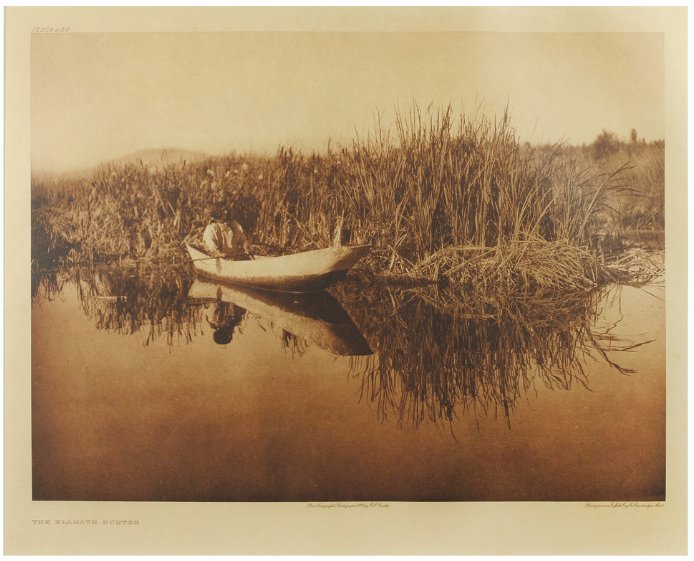
The Klamath Hunter by Edward S. Curtis, Photogravure, 1923
Presented is a beautiful photogravure showing a Klamath man hunting from a dugout canoe. This image is Plate 458 from Volume 13 of Edward Curtis' epic project The North American Indian. The photogravure was published in 1923 by Suffolk Engr. Co., in Cambridge, MA. The Klamath people are from the inland region of Northern California and Southern Oregon. Their oral history records the volcanic eruption that created Crater Lake over 7000 years ago.
Edward S. Curtis created one of the most enduring and iconic visual records in the history of the photographic medium. He was an award-winning artist, a consummate craftsman, a visionary, an intrepid entrepreneur, and was highly regarded as a respected ethnographer and publisher.
Curtis began photographing Native Americans in the mid-1890s and selling these images in his successful downtown Seattle studio. One of his earliest models was Princess Angeline, the aged daughter of chief Sealth, the Suquamish Indian after whom Seattle is named. At the National Photographic Convention of 1899 Curtis was awarded the grand prize for three of his soft-focused, sepia-toned images of Puget Sound Native Americans: Evening on the Sound, The Clam Digger, and The Mussel Gatherer.
Curtis spent the summer of 1900 with George Bird Grinnell observing the Sun Dance at an encampment of Blood, Blackfeet, and Algonquin in Montana. This was a pivotal experience for Curtis, confirming his desire to study and photograph the Native tribes of North America. A trip to visit the Hopi reservation in Arizona a few months later further fueled his enthusiasm.
Curtis envisioned a plan to create a massive scholarly and artistic work that would document the tribes west of the Mississippi, their ceremonies, beliefs, daily life, and landscapes. In 1906, Curtis approached railroad tycoon J.P. Morgan to request financial assistance for his project. Morgan agreed to pay him a total of $75,000, or $15,000 a year for five years. Morgan and Curtis decided that Curtis' masterwork, The North American Indian, would be a set of 20 volumes of ethnographic text illustrated with high quality photoengravings taken from his glass plate negatives. Each of these volumes would be accompanied by a portfolio of large size images, all sumptuously bound in Moroccan leather. The papers used for printing would also be of the best quality: a Dutch etching stock by Van Gelder, a Japanese vellum, and for the most discerning subscribers, a translucent Japanese tissue paper.
To fund publication, Curtis would sell subscriptions at approximately $3,000 per set, with a total of 500 sets to be published. An ambitious and extensive project, Curtis spent much of his life documenting as many Native tribes as possible. The importance and the urgency of the task was clear to him, as he wrote in the introduction to his first volume of The North American Indians in 1907, "The information that is to be gathered ... respecting the mode of life of one of the great races of mankind, must be collected at once or the opportunity will be lost."
In 1930, some 24 years after his initial request for funding, the last two volumes, Vol. 19 and Vol. 20, were published and The North American Indian project was finally completed. Curtis took over 40,000 photographs and made over 10,000 wax cylinder recordings to detail the lives, languages, and beliefs of over 80 different tribes. Curtis co-created this unparalleled artistic, anthropological record with an estimated 10,000 Native participants. His work changed the way an entire nation viewed Native Americans. He accomplished this at a time when some individuals were actively advocating for the continued relocation of numerous tribes. Today, many Native people and their tribes find Curtis’ work an invaluable source for cultural and linguistic revivification.
CONDITION:
Good condition. Photogravure. Unframed. Image size: 17.8" H x 21.8"W.
Accompanied by our company's letter of authenticity.
Pickup available at Colorado
Usually ready in 4 hours

The Klamath Hunter by Edward S. Curtis, Photogravure, 1923
Colorado
1 Lake Avenue
Colorado Springs CO 80906
United States
Choose options

Frequently Asked Questions
FAQs
Yes, all of our Antiques are certified authentic. Every antique comes with a signed Letter of Authenticity that details the item’s history, its current condition including any conservation, binding, or framing work, and the item’s provenance. The Letters of Authenticity are priced valuations by our authentication specialists, who assure that items are original and unconditionally guaranteed as genuine for life.
We pack and ship your items from our gallery in Colorado Springs. You may also choose to come pick up your order. Antique items are carefully packed and insured during shipping. The shipping price will be calculated at checkout.
We acquire from a variety of trusted sources all over the world, but mostly through auctions and private collections within the United States. All provenance information will be listed on the Letter of
Authenticity accompanying your purchase.

